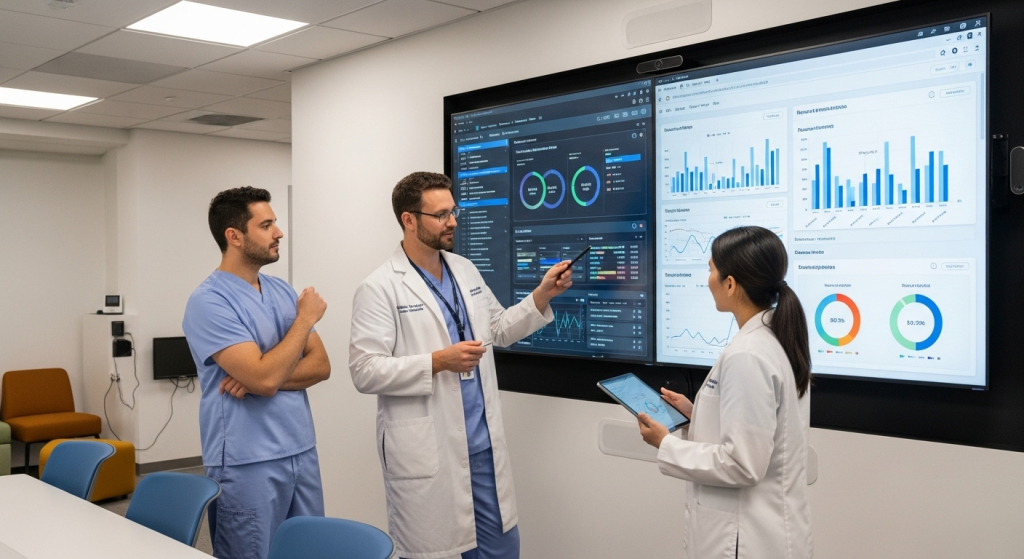The healthcare industry stands at the nexus of a technological revolution, besieged by rising costs, fragmented patient journeys, and an unprecedented volume of data. Electronic Health Records (EHRs), claims databases, genomic sequencing, and wearable devices are generating an estimated 30% of the world’s data. The figure is projected to grow at a staggering 36% CAGR through 2025. This explosion of raw data presents both a massive challenge and the single greatest opportunity for transformation.

To navigate this complexity and fulfill the promise of value-based care, healthcare providers can no longer rely on siloed spreadsheets or generic, off-the-shelf reporting tools. The future of precision medicine, optimized operations, and enhanced patient outcomes rests on the strategic development of custom healthcare analytics software. This approach is the key to transforming raw health data into the actionable, real-time insights required for data-driven decision-making.
Stop forcing generic tools into your unique clinical and operational reality. Consult our expert team, backed by SPsoft’s experience, to architect and deploy custom healthcare analytics software tailored to your needs!
Defining the Custom Advantage: Why Generic Doesn’t Cut It
While many commercial healthcare analytics solutions exist, they are designed for a broad market. Thus, they often fail to address the particular operational models, patient populations, and legacy IT infrastructure of individual providers or health plans. That is where the inherent value of custom healthcare analytics software emerges.
A custom solution is a purpose-built healthcare system created from the ground up to integrate seamlessly with an organization’s existing ecosystem. The latter includes multiple EHRs, Revenue Cycle Management (RCM) systems, and specialized clinical hardware. It is specifically engineered to solve your most pressing problems, whether that’s reducing readmission rates for a specific chronic condition, optimizing staffing in a multi-campus network, or detecting complex fraud patterns unique to a particular payer-provider arrangement.
Ready-Made vs. Custom: A Basic Comparison and Strategic Implications
The choice between a ready-made platform and a custom build boils down to a few critical trade-offs. While commercial products offer quicker deployment, they often introduce limitations in three crucial areas that directly impact core business strategy and patient safety:
| Feature | Off-the-Shelf Analytics Software | Custom Healthcare Analytics Software |
|---|---|---|
| Customization & Flexibility | Limited; pre-defined features and metrics. | Unlimited; tailored to unique workflows, specialties, and institutional goals. |
| Integration Capabilities | Limited to pre-built APIs; often struggles with legacy systems and data silos. | Designed for seamless, multi-directional data flow with all existing internal systems. |
| Security & Compliance | Standard, generic compliance (e.g., HIPAA-compliant hosting). | Enhanced, tailor-made security protocols, role-based access control, and audit logs built for the specific regulatory environment. |
| Data Granularity | Focuses on aggregated, high-level reporting. | Enables multi-dimensional segmentation, granular patient risk stratification, and root-cause analysis. |
| Return on Investment (ROI) | Moderate and standardized. | High (up to 350% ROI reported), driven by precision and efficiency. |
Beyond the technical features, the custom approach fundamentally alters a health system’s ability to innovate. Generic healthcare solutions force an organization to adapt its workflows to the software, constraining strategic evolution.
In contrast, custom health analytics software is a strategic asset designed to support and accelerate institutional transformation, such as the adoption of new, highly specialized care protocols or a major acquisition that requires rapid integration of disparate IT systems. For instance, a major healthcare network analytics initiative across multiple newly acquired clinics would fail spectacularly if a generic solution couldn’t handle the diverse legacy EHRs.
A bespoke solution, however, can normalize this complex data from multiple sources, ensuring the new network has a unified, 360-degree view of its patient population and financial health from day one. This level of agility is valuable in the rapidly consolidating and evolving healthcare analytics software market, enabling the organization to maintain its competitive edge and focus on delivering high-quality, specialized care without being technologically shackled. The high ROI is a direct result of this targeted precision, where the software addresses bottlenecks that off-the-shelf tools overlook.
The Four Pillars of Healthcare Analytics: From “What Happened?” to “What Should We Do?”
Healthcare analytics is not a single tool but a spectrum of capabilities that progressively unlock more profound insights. A robust custom healthcare analytics software platform will combine these four types to power a truly data-driven healthcare strategy:
| Analytics Type | Question Answered | Key Function in Medical Analytics | Clinical/Operational Application Example |
|---|---|---|---|
| Analytics Type | Question Answered | Key Function in Medical Analytics | Clinical/Operational Application Example |
| Descriptive | What happened? | Summarizing past events and performance. | Analyzing last quarter’s hospital readmission rates or identifying peak times for ED visits. |
| Diagnostic | Why did it happen? | Identifying root causes, correlations, and contributing factors. | Tracing a spike in claim denials back to a specific coding error or process step. |
| Predictive | What will happen? | Forecasting future outcomes and calculating risk. | Identifying patients at high risk of sepsis or cardiac arrest; forecasting bed occupancy. |
| Prescriptive | What should we do? | Recommending optimal actions to achieve a desired outcome. | A Clinical Decision Support (CDS) system suggesting an optimal personalized discharge plan and follow-up intervention. |
The transition across these four categories represents the maturation of a truly data-driven decision-making culture in healthcare. Descriptive analytics, while useful for reporting, only offers a rearview mirror perspective. The strategic value of predictive analytics in healthcare truly escalates.
For instance, a custom-built predictive model might ingest data points from a high-risk heart failure patient’s EHR, including weight fluctuations, medication adherence data from an integrated app, and recent lab values. That can help healthcare providers calculate a precise, color-coded risk score for readmission within the next 30 days. This level of foresight is vital for preemptive care.
However, the ultimate goal is Prescriptive Analytics. This level requires the analytical engine to combine the prediction (risk of readmission is 85%) with institutional knowledge to generate a recommended action: “Initiate daily tele-monitoring calls, prescribe a low-sodium meal plan through the integrated catering service, and schedule a social worker home visit.”
That moves the system beyond mere insight to immediate, automated action that changes the course of a patient’s health trajectory, embodying the highest form of healthcare analytics. The sophistication of this final, prescriptive stage is achievable through custom healthcare analytics solutions tailored to the unique resources and protocols of health organizations.
Three Core Benefits of Bespoke Analytics
Implementing dedicated, custom healthcare analytics software provides transformative benefits across both the clinical and operational spheres of a healthcare organization.

1. Elevating Clinical Care and Patient Outcomes
Custom analytical tools empower clinicians with real-time, personalized information, shifting the focus from treating illness to managing wellness and preventing critical events.
- Precision and Personalized Medicine. By integrating diverse patient data (such as genomic data, longitudinal EHR data, and continuous biometric feeds from wearables), custom healthcare data analytics solutions tailor treatment protocols to an individual’s unique biological and lifestyle profile. This high-fidelity view supports precision medicine, leading to higher treatment efficacy and reduced adverse side effects.
- Proactive Risk Intervention. Advanced predictive modeling is integrated directly into clinical workflows to flag high-risk patients hours or even days before a critical event occurs. For instance, the collaboration between UCSF Health and GE Healthcare on a predictive platform successfully drove a 30% drop in mortality rates and a 35% reduction in hospital readmissions by enabling proactive intervention based on real-time deterioration alerts.
- Drug Safety and Medication Management. Custom platforms analyze millions of medication orders against patient profiles and institutional guidelines, using sophisticated algorithms to detect potential drug-to-drug or drug-to-allergy interactions. That reduces Adverse Drug Events (ADEs). The Cleveland Clinic, through advanced analytics, achieved a notable decrease in medication errors and related hospitalizations.
The result is a more informed, proactive, and safer clinical environment, demonstrating how targeted medical analytics directly translates into superior patient experiences and outcomes.
2. Driving Operational and Financial Efficiency
The second central area of impact lies in optimizing the complex financial and operational mechanics of the healthcare business, directly boosting profitability and resource stewardship.
- Revenue Cycle Management (RCM) Optimization. Financial analytics can quickly detect fraudulent insurance claims, phantom billing, and flag suspicious activities for investigation. Furthermore, RCM automation, powered by predictive models, significantly reduces denial rates and eases administrative burdens across the entire billing cycle, directly boosting the bottom line.
- Resource and Supply Chain Management. Custom dashboards provide real-time visibility into resource utilization, from operating room block scheduling and high-value equipment tracking to optimizing inventory levels based on forecast demand. This level of precise inventory and asset management improves operational efficiency and minimizes costly wastage of medical supplies.
- Patient Flow and Load Management. Hospitals can use analytics to predict patient influx, optimize appointment scheduling, and prevent bottlenecks in high-volume areas such as the Emergency Department and imaging centers. By optimizing staff and bed allocation based on predictive modeling, this improves operational efficiency, reduces wait times, and ultimately elevates overall patient satisfaction ratings.
The operational improvements driven by custom healthcare data analytics software often translate directly into the high reported ROI figures. On the financial side, a bespoke system can utilize AI to predict the likelihood of claim denial before a claim is submitted, reducing the Days Sales Outstanding (DSO) and ensuring the organization focuses its limited resources on strategic initiatives rather than manual rework. That moves beyond generic cost-cutting to proper strategic optimization of every dollar and every minute spent on patient care.
3. Supporting Population Health Management
For healthcare companies operating under value-based care models, population health management is paramount. Custom analytical health systems provide the complex, multi-layered data needed to manage the health of an entire community effectively.
- Granular Risk Stratification. Healthcare network analytics is used to ingest and analyze data across claims, clinical records, and even social determinants of health (SDOH). Custom software can perform highly granular risk stratification, identifying entire sub-populations (not just individuals) most likely to benefit from a targeted clinical outreach campaign for conditions like diabetes or COPD.
- Proactive Care Pathway Intervention. This level of analysis allows providers and health plan analytics teams to intervene with preventative care and manage chronic conditions more effectively. By segmenting high-risk groups, the system can automatically trigger customized outreach, educational resources, or appointment scheduling, ultimately reducing costly, avoidable acute events in the future.
- Measuring Value-Based Care Success. Custom platforms are built to align with specific payer contracts and value-based metrics. They accurately measure and report on key performance indicators (KPIs) such as per-member-per-month costs, preventive care compliance rates (e.g., flu shots, mammograms), and quality outcomes, providing the auditable evidence needed to secure performance bonuses.
Custom healthcare analytics software is the critical tool for organizations shifting to value-based care. The system’s ability to create a unified view of population health enables them to replicate successes like Kaiser Permanente’s. They leveraged predictive analytics to proactively identify and manage high-risk patients across its vast membership, leading to documented reductions in hospitalizations and improved overall health metrics for the community.
Implementation: Challenges and the Custom Solution
The path to a fully data-driven healthcare enterprise is fraught with significant hurdles. A bespoke healthcare software development strategy is uniquely positioned to address these core challenges.

Data Silos and the Interoperability Crisis
The healthcare landscape is famously fragmented, with critical patient information trapped in various, non-communicating systems (EHRs, Picture Archiving and Communication Systems (PACS), billing software, etc.). Over 60% of healthcare executives cite data silos as a major barrier to effective analytics.
The Custom Solution: Unlike off-the-shelf products that rely on pre-built, often insufficient, connectors, custom healthcare analytics software is architected with a specific focus on interoperability. Developers and data analysts can use specialized data integration tools, embrace modern standards (such as FHIR), and build a proprietary health data insights platform. That is a centralized data warehouse designed to unify all data streams within the organization, regardless of source or format.
Overcoming the challenge of interoperability requires moving beyond simple Foundational (data exchange) and Structural (standardized formats like HL7) levels to achieve Semantic Interoperability. This advanced level ensures that different systems not only exchange data but also understand it in a unified way, using common clinical terminology and standardized codes (such as SNOMED CT for concepts or ICD-10 for diagnoses).
The custom solution: Semantic Interoperability is a design requirement, creating a comprehensive internal data dictionary and a standard data model that maps all incoming data sources. That is critical for the accuracy of medical analytics. For instance, a prescription written in one EHR must be semantically understood by the healthcare analytic engine and the pharmacy system as the same entity, preventing medication errors and ensuring correct billing.
Ensuring Data Quality and Accuracy
The quality of any analytics output is directly tied to the quality of the input. In healthcare, poor data quality, from typing errors in patient records to incomplete or duplicated information, can have life-or-death consequences.
The Custom Solution: A bespoke system can embed real-time data validation and sophisticated cleaning protocols directly into the data ingestion layer. For example, it can use machine learning to flag outliers or Natural Language Processing (NLP) to structure critical, unstructured data in physician notes. That ensures the highest level of accuracy for subsequent decision-making.
Compliance and Security (HIPAA, GDPR, etc.)
Handling sensitive patient health information (PHI) requires proper attention to security and compliance. Data breaches are financially devastating and severely erode patient trust.
The Custom Solution: Security is built into the architecture. A custom solution guarantees compliance with regulations like HIPAA by implementing stringent measures such as end-to-end data encryption, detailed audit logging, and precise, role-based access controls. They ensure, for example, that an administrative staff member only sees the financial data relevant to their role, not a physician’s clinical notes.
Clinician Resistance and User Adoption
Even the most powerful analytics tool is useless if clinicians find it cumbersome, confusing, or disruptive to their existing workflows. Data tools often fail because they impose a new data entry burden on physicians.
The Custom Solution: Bespoke design allows for tailored user interfaces (UIs) and dashboards for different user groups (physicians, administrators, nurses). Crucially, the system is designed to integrate analytics and healthcare workflows seamlessly. The insight (e.g., the sepsis risk alert) is surfaced directly within the EHR system at the moment the clinician is making the decision, minimizing workflow disruption and maximizing the insight’s utility.
Furthermore, tackling the high implementation cost through customization is a financial advantage. By targeting the software’s functionality only to the most impactful pain points (such as the exact RCM process or a single, high-cost chronic condition) organizations can achieve a quicker payback period and justify the investment based on documented financial returns, rather than spending on a bloated, generic system that provides features they will never use.
The Custom Solution: The custom system must be developed with a focus on “ambient intelligence”. These tools automate documentation (using NLP to summarize clinical encounters) or provide passive, high-value insights, truly making the system an assistant, not a hindrance, to patient care.
Emerging Trends in Advanced Healthcare Analytics
The velocity of innovation in healthcare IT analytics is accelerating, driven by the maturity of Artificial Intelligence (AI) and Big Data infrastructure.

- AI-Powered Diagnostics. AI algorithms, trained on massive datasets of medical images (like the healthcare data analytics and predictive modeling HD images) are beginning to match or surpass human accuracy in tasks like identifying diabetic retinopathy or breast cancer from mammograms. A custom platform can integrate these specialized models directly into the clinical workflow.
- Genomic and Multi-Omics Data Integration. As genomic sequencing becomes routine, custom software will be necessary to process and contextualize petabytes of genetic data alongside traditional EHR data to enable truly personalized drug and treatment selection.
- Edge Computing and Real-Time IoT Analytics. With the proliferation of Internet of Medical Things (IoMT) devices and wearables, a custom platform must be able to process real-time data streams at the edge (i.e., near the data source) to provide immediate, life-saving alerts, such as heart rate variability warnings for patients managing chronic conditions at home.
- The Rise of Health Data Insights Platforms. The shift from simple data warehouses to sophisticated Health Data Insights Platforms means that the future is about creating an intelligent, self-optimizing ecosystem. These platforms, often cloud-native, will be the unified source of truth, enabling continuous learning and automatic feedback loops that refine predictive models as new patient outcomes are recorded.
- AI and Genomic Data. ML models are being trained to analyze sequencing data to identify genetic variations, predict disease susceptibility (cancer or neurodegenerative disorder risk), and forecast individual responses to specific medications. For instance, in oncology, a custom analytical platform can combine a patient’s tumor genome sequence with EHR data to recommend a highly personalized chemotherapy or immunotherapy regimen. That allows for predicting treatment efficacy before it begins.
Ultimately, the next generation of custom healthcare analytics software is already incorporating these trends.
Conclusion: Investing in Custom Software for a Healthier Future
The investment in custom healthcare analytics software is an investment in the strategic future of a health organization. It is the definitive move away from reactive, fragmented care toward a proactive, unified, and truly data-driven healthcare model.
While the initial investment is substantial, the long-term ROI is overwhelmingly compelling, with returns reported up to 350%. These returns are generated through the priceless improvement in patient care quality — fewer errors, faster diagnoses, more personalized treatment, and a healthier population. For organizations looking to survive and thrive in the era of value-based care, building a bespoke analytics backbone is no longer optional. It is the essential next step toward achieving a truly optimized, intelligent, and human-centric system of care.
Your future is data-driven healthcare. Work with us to design custom healthcare analytics software that includes semantic interoperability, real-time risk stratification, and automated RCM optimization!
FAQ
What is the main difference between generic and custom healthcare analytics software?
The fundamental difference is fit and function. Generic software offers broad, limited features, forcing your organization to adapt. Custom healthcare analytics software, in contrast, is purpose-built to integrate seamlessly with your unique EHRs, RCM systems, and clinical workflows. This bespoke design ensures you receive highly granular data, superior data security, and models tailored to your specific challenges, maximizing ROI and clinical accuracy.
How does custom analytics transform patient outcomes beyond basic reporting?
Custom analytics moves beyond “what happened” (descriptive) into predictive and prescriptive analytics. That means the system doesn’t just show high readmission rates; it identifies which specific patients are at risk and prescribes the exact intervention needed (e.g., a home visit or medication change). This proactive risk stratification, powered by tailored models, directly reduces adverse events and lowers mortality rates.
What is the potential return on investment (ROI) for building a custom platform?
The ROI for custom healthcare analytics software can be significantly higher than off-the-shelf options, with some reports indicating returns of up to 350%. This high return is driven by targeted efficiency gains in RCM (reducing claim denials), optimizing the utilization of expensive resources, and preventing costly acute events through early patient intervention. The bespoke nature ensures that every dollar spent targets the most critical organizational bottlenecks.
How does custom software address the chronic issue of data silos in healthcare?
Data silos, where critical information is trapped across disparate systems, are overcome through a commitment to advanced interoperability. Custom solutions are architected to create a unified health data insights platform (data warehouse) that supports semantic interoperability. That ensures all data streams (EHRs, labs, billing) not only connect but are also interpreted consistently, providing an accurate 360-degree view of the patient and operation.
In the move to value-based care, what role does custom network analytics play?
For organizations engaging in value-based care, custom healthcare analytics software is vital for effective population health management. It performs granular risk stratification across an entire network, integrating clinical data with social determinants of health (SDOH). That allows providers to proactively deploy targeted outreach and preventative programs to high-risk groups, reducing per-member costs and providing the auditable metrics needed to meet contract obligations.
What is the highest level of intelligence a custom analytics system can achieve?
The highest level of intelligence is prescriptive analytics. That goes beyond predicting an event to suggesting the optimal, automated course of action. For example, the system might predict a 90% risk of complications and immediately recommend a specific clinical order or reallocate resources to mitigate that risk, demonstrating the apex of advanced analytics in healthcare and real-time decision support.
How are AI and genomic data integrated into a custom analytics platform?
Custom platforms are necessary to merge the vast scale of genomic and multi-omics data with traditional EHR information. Machine Learning (ML) algorithms are trained within a healthcare analytics software solution to predict personalized drug responses and disease susceptibility. Furthermore, methods such as Federated Learning are integrated to enable AI model training without compromising patient privacy or transferring highly sensitive genomic data.



